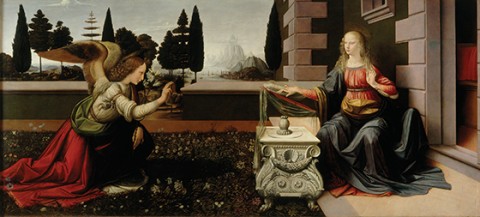Annunciation, by Leonardo da Vinci (1452–1519)

The importance of the annunciation to medieval and Renaissance Florentines is best reflected in the fact that until 1750 the beginning of the new year corresponded directly to the Feast of the Annunciation, March 25. Leonardo’s Annunciation, probably commissioned for the monastery of Monte Oliveto outside Florence, depicts the initial moment of encounter between Gabriel and Mary, when Gabriel announces to Mary: “The Lord is with you!” (in the Vulgate: Dominus tecum). Mary is seated behind a lectern, which is best understood as an altar, underscoring her priestly role. On the lectern rests a book whose fluttering pages (presumably stirred by the rush of Gabriel’s arrival) are stilled by Mary’s fingers. The 13th-century Meditations on the Life of Christ (written by a Franciscan monk in Tuscany) suggests that at the moment Gabriel appeared, Mary may have been reading Isaiah 7:14, a passage traditionally understood as a prophecy of the virginal birth. The lily that Gabriel holds is a symbol of Mary’s purity.




